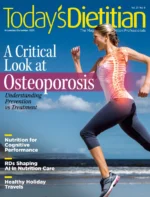By Danielle Nierenberg
Did you know that water in the United States is becoming scarcer? However, your patients and clients (and you too) can take some simple steps in the grocery store and kitchen to reduce water usage and preserve this resource.
Many Americans use as much water as approximately 900 Kenyans. As a result, water resources in the United States are shrinking. In the last five years, there have been water shortages in almost every part of the country, including the worst drought in at least 25 years, which hit 80% of the country’s farmland in 2012. Even worse, the damaged land won’t fully recover this year, and at least 36 states are expecting local, regional, or statewide water shortages even without drought.
The Natural Resources Defense Council expects water scarcity to affect the American South, West, and Midwest the most. Fourteen states in these regions already have an extreme or high risk of water scarcity. Arizona, Florida, Idaho, Nevada, and Texas face the most danger because these states are expected to see some of the largest increases in population by 2030.
Water scarcity is about more than lack of water, though; it’s about lack of drinkable water. It’s estimated that as many as 53.6 million Americans have contaminated tap water.
But as consumers, we can profoundly reduce water waste and water consumption through the food choices we make. Recent research from the Barilla Center for Food & Nutrition shows that a healthful diet and an environmentally sustainable diet can go hand in hand.
Strategies for Conservation
Here are five steps you and your clients can take to begin saving water:
1. Eat less meat. Switching from a meat-centered weekly menu to a diet rich in vegetables and grains can save 2,500 L of water a day. Eating grass-fed and locally raised meat, eggs, and dairy products also can save water.
2. Steam veggies. In general, you use less water to steam than boil vegetables, and according to a study in the Journal of Food Quality, steaming is more nutritious. For example, boiling corn on the cob in a large pot may use 6 to 8 qt of water, whereas steaming only uses 1 to 2 qt. If you must boil vegetables, save the water for your garden or soup stock.
3. Support small-scale, family farms. Agricultural subsidies in the United States disproportionately support large-scale agribusinesses over the small-scale producers who are more likely to be engaged in sustainable food production and may be challenged by drought or commodity price fluctuations. Changes in government support services can reduce this deficit and improve food and water security.
4. Streamline water use in home gardens. During the summer months, the Environmental Protection Agency (EPA) reports that nearly 40% of household water is used for watering lawns and gardens. National Geographic suggests incorporating native plants into your garden since they’re adapted to the local climate and often require less water. Manually watering plants instead of using automatic sprinklers cuts water use by 33%, according to a report by the EPA. Consumers also can buy self-watering planters or construct rain barrels that can save you up to 1,300 gal of water.
5. Reduce food waste. The UN Food and Agriculture Organization reports that nearly one-third of all food produced for human consumption is wasted throughout production, storage, transportation, consumption, and disposal. Teach clients about their food’s shelf life and how long they can store food in their freezers. Other ways to reduce food waste include buying only what they plan to eat, using leftovers to create new meals, or donating to soup kitchens food that would otherwise go to waste.
— Danielle Nierenberg is a food and agriculture expert and cofounder of Food Tank: The Food Think Tank.


